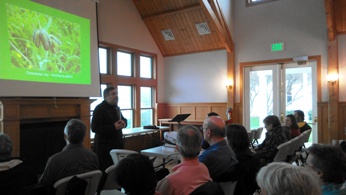— by Margie Doyle —
They are beautiful and they are gruesome: the Frosted Nudibranch and Porcelein Crab, the Haemobaphes diceraus parastice penelid copepod, viral hemorrhagic septicemia and the Blue-eyed Mary wildflower. And they all live together on or off-shore Indian Island.
They were pictured and talked about to a full house at the Episcopal Parish Hall on Saturday, March 15 at the 3rd annual “Tides of March” report of Indian Island Marine Health Observatory. The marine observatory is maintained by Kwiáht non-profit (Kwiáht means, “a spiritually clean place’) and by the BeachWatchers ( a WSU Extension program).
Barsh noted that the meeting was the last indoor event of the season and welcomed new and returning volunteers to the field work of Kwiáht and Beachwatchers in monitoring the conditions of our local marine ‘laboratory’. “We’re looking for able-bodied and quick-witted volunteers… to see what’s under our toes.”
He announced that a new Orcas marine health observatory is opening at Skull Island, and that a partnership of the Funhouse, Orcas Recycling Services (ORS), Kwiáht, and Irthlingz are seeking funding for the recently-formed Youth Ecology Arts Action group of YEAA! Barsh said the group would focus on joining art and science, and its first project will be an interactive map of Indian Island and the surrounding area.
Erica Berdan, a donor and a volunteer for the Indian Island Marine Health Observatory, introduced the audience to the multitudes of plankton that exist in sea water; plankton are the microscopic plant organisms that are the base of the marine food chain. Monitoring plankton in local waters creates “an early detection system for Puget Sound marine life.” Sixth-grade students will we working on plankton biology, which can be collected nearby in “substantial diversity. It’s a wonderful way to start studying marine biology,” said Berdan who has worked with Barsh to acquire the BioTek Microplate Reader, which is to measure algal toxins, stress hormones in fish, and contaminants such as pesticides and dioxins.
Madrona Murphy spoke of the terrestrial habitat of Indian Island, that often gets overlooked and the “suprisingly diverse” wildflowers. She described the afore-mentioned “Blue-eyed Mary,” saying, “if you smell the odor of ‘wet dog,’ well, you’re smelling Blue-eyed Mary.”
Kelly Rose, volunteer coordinator noted the 4,300 visitors to Indian Island that were recorded last year, and added that those are on-foot, low-tide-only visitors to just over one acre. “We have to be there to welcome them and to usher them into the experience of Indian Island in a way that provides for sustainability and recovery,” she said.
Barsh then presented a slide show of the complex chemistry, biology — including microbiology — of marine life, and at times it was like seeing a horror movie in miniature, with the parasitic copepod that is only stomach and eggs attached to the gills of the Shiner Perch; or the “leprous white lesions” of the seastar wasting syndrome; or the chemical rock eaters.
According to Barsh, marine bacteria was largely unstudied until the 1980s; further marine bacteria and viruses can that can quickly adapt to changing conditions, as opposed to mammals that take thousands of years to mutate.
He suggested climate change may be the instigator for the increase in marine diseases; among the components of climate change affecting marine life are:
- rising ocean water temperatures
- contaminant stress on immune systems
- acidification stress on immune system
- antibiotic resistance
Or Barsh suggested, the increase in marine disease may be an indicator of “increasing vigilance.”
“The ocean has adapted to enormous changes, but the bacterial and viral communities are now most likely to change — and we don’t know what the implications are,” Barsh said.
For more information, go to www.IndianIsland.info
**If you are reading theOrcasonian for free, thank your fellow islanders. If you would like to support theOrcasonian CLICK HERE to set your modestly-priced, voluntary subscription. Otherwise, no worries; we’re happy to share with you.**








